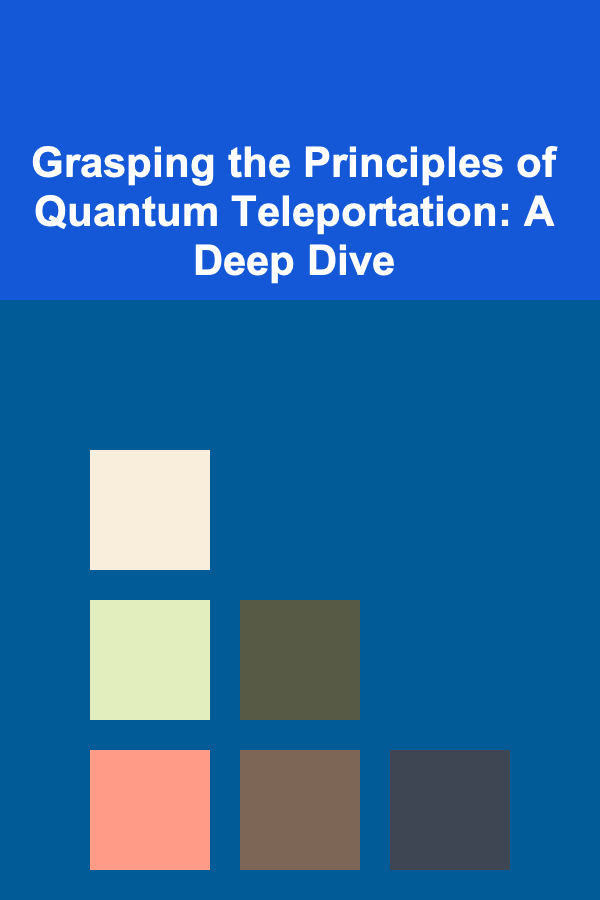
Grasping the Principles of Quantum Teleportation: A Deep Dive
ebook include PDF & Audio bundle (Micro Guide)
$12.99$10.99
Limited Time Offer! Order within the next:

Quantum teleportation, often hailed as one of the most groundbreaking concepts in quantum mechanics, frequently evokes images of instantaneous matter transfer reminiscent of science fiction. However, the reality is far more nuanced and, arguably, even more fascinating. It's crucial to understand from the outset that quantum teleportation does not involve physically transporting matter. Instead, it's a process by which the quantum state of a particle is transferred from one location to another, relying on the intertwined phenomena of quantum entanglement and classical communication. This essay will delve into the intricate details of quantum teleportation, elucidating its fundamental principles, its implications, and its limitations.
Deconstructing the Misconceptions
Before embarking on a detailed explanation, it's essential to address common misconceptions. The term "teleportation" itself is partly to blame for the confusion. It conjures images of dissolving an object in one place and reconstituting it perfectly in another. This is not what happens in quantum teleportation. Key points to remember are:
- No Matter is Physically Transferred: The original particle whose state is being teleported is not physically moved. The process destroys the original particle's state at the sender's end.
- Information Transfer, Not Matter Transfer: What is teleported is the quantum state of the particle. This state, encoded within the particle, is the information being transmitted.
- Classical Communication is Essential: Quantum teleportation relies on a combination of quantum entanglement and classical communication. The classical communication step is crucial and limits the speed of the teleportation process to the speed of light. There is no faster-than-light information transfer.
- The No-Cloning Theorem: A fundamental principle of quantum mechanics, the No-Cloning Theorem, states that it's impossible to create an identical copy of an arbitrary unknown quantum state. Quantum teleportation doesn't violate this theorem because the original state is destroyed in the process. The receiver gets a particle in the original state, but the sender no longer possesses the original particle in that state.
The Building Blocks: Entanglement, Qubits, and Measurement
To truly understand quantum teleportation, one must first grasp some fundamental concepts of quantum mechanics:
Quantum Entanglement: Spooky Action at a Distance
Entanglement is arguably the most bizarre and counterintuitive aspect of quantum mechanics. It describes a situation where two or more particles become linked together in such a way that they share the same fate, no matter how far apart they are. Specifically, their quantum states are correlated. Measuring the state of one entangled particle instantly influences the state of the other, even if they are separated by vast distances. This seemingly instantaneous correlation is what Einstein famously referred to as "spooky action at a distance."
Mathematically, entangled states are described by superpositions of states. Consider two qubits, A and B. A maximally entangled state (a Bell state) can be represented as:
|Φ+⟩ = (1/√2) (|0⟩A|0⟩B + |1⟩A|1⟩B)
This means that when qubit A is measured to be in state |0⟩, qubit B will always be measured to be in state |0⟩, and when qubit A is measured to be in state |1⟩, qubit B will always be measured to be in state |1⟩. The correlation is perfect.
Crucially, knowing the outcome of measuring qubit A does not tell you the overall state of the system. The system is still in a superposition of |00⟩ and |11⟩ until a measurement is made. This prevents the use of entanglement for faster-than-light communication.
Qubits: The Quantum Bit
In classical computing, the fundamental unit of information is the bit, which can be either 0 or 1. In quantum computing, the fundamental unit is the qubit (quantum bit). A qubit can exist in a superposition of states, meaning it can be both 0 and 1 simultaneously. This is represented mathematically as:
|ψ⟩ = α|0⟩ + β|1⟩
where α and β are complex numbers such that |α|^2^ + |β|^2^ = 1. |α|^2^ represents the probability of measuring the qubit to be in the state |0⟩, and |β|^2^ represents the probability of measuring the qubit to be in the state |1⟩.
The power of quantum computing lies in this superposition principle. By existing in multiple states simultaneously, qubits can perform computations that are impossible for classical bits.
Quantum Measurement: Collapsing Superposition
When a qubit is measured, its superposition collapses into one of the definite states, either |0⟩ or |1⟩. The outcome of the measurement is probabilistic, determined by the amplitudes α and β. Once the measurement is made, the qubit is no longer in a superposition, and its state is now definitively known. This collapse is irreversible and destroys the original quantum state.
The Quantum Teleportation Protocol: Step-by-Step
Now, let's break down the quantum teleportation protocol step-by-step, considering Alice (the sender) and Bob (the receiver).
- Shared Entanglement: Alice and Bob share a pair of entangled qubits. Crucially, they each possess one qubit of the entangled pair. This entangled pair is often prepared beforehand and distributed to Alice and Bob through some quantum channel. The entangled pair is typically in one of the Bell states, like the one described earlier: |Φ^+^⟩ = (1/√2) (|0⟩~A~|0⟩~B~ + |1⟩~A~|1⟩~B~). Let's designate Alice's qubit as qubit 2 and Bob's qubit as qubit 3.
- The Unknown State: Alice possesses a qubit (qubit 1) whose state she wants to teleport to Bob. This qubit is in an unknown state |ψ⟩ = α|0⟩ + β|1⟩, where α and β are unknown complex numbers. The goal is to transfer this state |ψ⟩ to Bob.
- Alice's Bell Measurement: Alice performs a Bell measurement on her two qubits (qubit 1 and qubit 2). A Bell measurement is a special type of joint measurement that projects the two qubits into one of four Bell states:
- |Φ^+^⟩ = (1/√2) (|00⟩ + |11⟩)
- |Φ^-^⟩ = (1/√2) (|00⟩ - |11⟩)
- |Ψ^+^⟩ = (1/√2) (|01⟩ + |10⟩)
- |Ψ^-^⟩ = (1/√2) (|01⟩ - |10⟩) The outcome of this measurement is random, but it collapses the entanglement between all three qubits. Importantly, the result of this Bell measurement does not reveal any information about the original state |ψ⟩.
- Classical Communication: Alice communicates the result of her Bell measurement to Bob via a classical channel (e.g., phone, email, internet). This is a crucial step, and it is limited by the speed of light. Alice needs to tell Bob which of the four Bell states she measured. This requires two classical bits of information.
- Bob's Correction: Based on the two classical bits he receives from Alice, Bob performs a specific unitary operation on his qubit (qubit 3). The unitary operation is chosen based on Alice's measurement result. There are four possible operations:
- If Alice measured |Φ^+^⟩, Bob does nothing (identity operation).
- If Alice measured |Φ^-^⟩, Bob applies a Z gate (Pauli-Z gate).
- If Alice measured |Ψ^+^⟩, Bob applies an X gate (Pauli-X gate).
- If Alice measured |Ψ^-^⟩, Bob applies an X gate followed by a Z gate (Pauli-X then Pauli-Z). These operations effectively "correct" Bob's qubit, transforming it into the original state |ψ⟩ = α|0⟩ + β|1⟩.
- The Result: After Bob applies the appropriate correction, his qubit (qubit 3) is now in the exact same quantum state as the original qubit (qubit 1) that Alice wanted to teleport. The quantum state has been teleported from Alice to Bob. Critically, Alice's original qubit 1 is now in an unknown, randomized state due to the Bell measurement. Its original quantum state has been destroyed.
Mathematical Formalism: A Deeper Understanding
While the step-by-step explanation provides a conceptual understanding, a deeper appreciation of quantum teleportation requires a glimpse into the underlying mathematical formalism. Let's re-examine the process using Dirac notation and linear algebra.
The initial state of the three qubits (Alice's unknown qubit 1 and the entangled pair qubits 2 and 3) can be written as:
|Ψ⟩initial = |ψ⟩1 ⊗ |Φ+⟩23 = (α|0⟩1 + β|1⟩1) ⊗ (1/√2) (|00⟩23 + |11⟩23)
Expanding this expression, we get:
|Ψ⟩initial = (1/√2) [ α|000⟩ + α|011⟩ + β|100⟩ + β|111⟩ ]
Now, we rewrite this state in terms of the Bell basis for qubits 1 and 2. This involves expressing the terms in the form of combinations of the four Bell states. We can rewrite |00⟩, |01⟩, |10⟩, and |11⟩ in terms of the Bell states |Φ^+^⟩, |Φ^-^⟩, |Ψ^+^⟩, and |Ψ^-^⟩. After some algebraic manipulation (which is omitted here for brevity but can be found in most quantum mechanics textbooks), we obtain:
|Ψ⟩initial = (1/√2) [ |Φ+⟩12 (α|0⟩3 + β|1⟩3) + |Φ-⟩12 (α|0⟩3 + β|1⟩3)
+ |Ψ+⟩12 (α|1⟩3 + β|0⟩3) + |Ψ-⟩12 (α|1⟩3 - β|0⟩3) ]
Notice that the state is now expressed as a superposition of Bell states for qubits 1 and 2, each multiplied by a corresponding state for qubit 3. This is crucial because it demonstrates the effect of Alice's Bell measurement. When Alice performs her Bell measurement on qubits 1 and 2, she projects the system into one of the four Bell states. Let's say she measures |Φ^+^⟩~12~. Then, the state of qubit 3 collapses to (α|0⟩~3~ + β|1⟩~3~) = |ψ⟩~3~. However, the outcome of her measurement is probabilistic, and the state of qubit 3 will be different depending on the result. This is why classical communication is necessary.
The classical communication provides Bob with the information about which Bell state Alice measured. Based on this information, Bob applies the appropriate unitary transformation to his qubit (qubit 3) to transform it into the desired state |ψ⟩. The following table summarizes the necessary corrections:
Bell State Measured by Alice | Bob's Required Operation
----------------------------- | --------------------------
|Φ+⟩ | Identity (I)
|Φ-⟩ | Pauli-Z (Z)
|Ψ+⟩ | Pauli-X (X)
|Ψ-⟩ | Pauli-X then Pauli-Z (XZ)
By applying the correct operation, Bob reconstructs the original quantum state |ψ⟩ on his qubit.
The Significance and Limitations
Quantum teleportation, while not teleporting matter, has profound implications for quantum information processing. Its significance lies in:
- Quantum Communication: It provides a method for reliably transferring quantum information between distant locations, a critical component for building quantum networks and quantum internet.
- Quantum Computation: It can be used to implement quantum gates and algorithms in a distributed manner, allowing for the creation of more powerful and scalable quantum computers.
- Quantum Cryptography: It can enhance secure communication protocols by enabling the transfer of quantum keys without the risk of interception.
However, it's essential to acknowledge the limitations of quantum teleportation:
- Classical Communication Bottleneck: The speed of teleportation is limited by the speed of light due to the necessity of classical communication. This makes instantaneous or faster-than-light teleportation impossible.
- Entanglement Requirement: Pre-shared entanglement is crucial. The quality and distance over which entanglement can be maintained are current technological challenges. Generating and distributing high-fidelity entangled pairs over long distances is a significant hurdle.
- Fidelity Imperfections: In real-world implementations, the teleportation process is not perfect. Noise and imperfections in the quantum channels and devices can introduce errors, resulting in a teleported state that is not an exact replica of the original. Fidelity, a measure of the similarity between the original and teleported states, is a crucial metric in assessing the performance of quantum teleportation protocols.
- Resource Intensive: Quantum teleportation requires significant resources, including highly controlled quantum systems and precise measurement techniques. Scaling up the technology for practical applications is a major challenge.
Experimental Realizations and Future Directions
Despite the challenges, quantum teleportation has been experimentally demonstrated in various systems, including photons, atoms, and superconducting circuits. Early experiments demonstrated teleportation over short distances, but advancements in quantum technology have enabled teleportation over increasingly longer distances. For example, teleportation has been achieved over fiber optic cables spanning hundreds of kilometers and even between ground stations and satellites.
The future of quantum teleportation lies in several key areas of development:
- Improving Entanglement Distribution: Developing more efficient and robust methods for generating and distributing entangled states over long distances, potentially using quantum repeaters to overcome losses in quantum channels.
- Enhancing Fidelity: Reducing noise and improving the precision of quantum operations to increase the fidelity of teleportation. This requires advancements in quantum control techniques and error correction protocols.
- Integrating with Quantum Networks: Integrating quantum teleportation into larger quantum networks to enable secure quantum communication and distributed quantum computing.
- Exploring Novel Applications: Discovering new applications of quantum teleportation beyond communication and computation, such as in quantum sensing and metrology.
Conclusion
Quantum teleportation, while not the instantaneous matter transfer of science fiction, represents a profound and transformative concept in quantum mechanics. It demonstrates the power of quantum entanglement and its potential to revolutionize communication, computation, and cryptography. While significant challenges remain in scaling up the technology and improving its fidelity, ongoing research and development efforts are paving the way for practical applications of quantum teleportation in the future. Understanding the fundamental principles of quantum teleportation is crucial for anyone seeking to engage with the exciting and rapidly evolving field of quantum information science. It serves as a powerful reminder of the counterintuitive yet deeply fascinating nature of the quantum world and its potential to reshape our technological landscape.

How to Arrange Furniture for Better Flow in a Compact Space
Read More
How to Balance Full-Time Work and Writing Part-Time from Home
Read More
How to Invest in Precious Metals as a Hedge Against Inflation
Read More
How to Sell Vintage Toys at a Local Flea Market: An Actionable Guide
Read More
The Ultimate Guide to Saving Money on Landscaping and Gardening Projects
Read More
How to Create a Business Plan for a Freelance Consultant
Read MoreOther Products

How to Arrange Furniture for Better Flow in a Compact Space
Read More
How to Balance Full-Time Work and Writing Part-Time from Home
Read More
How to Invest in Precious Metals as a Hedge Against Inflation
Read More
How to Sell Vintage Toys at a Local Flea Market: An Actionable Guide
Read More
The Ultimate Guide to Saving Money on Landscaping and Gardening Projects
Read More